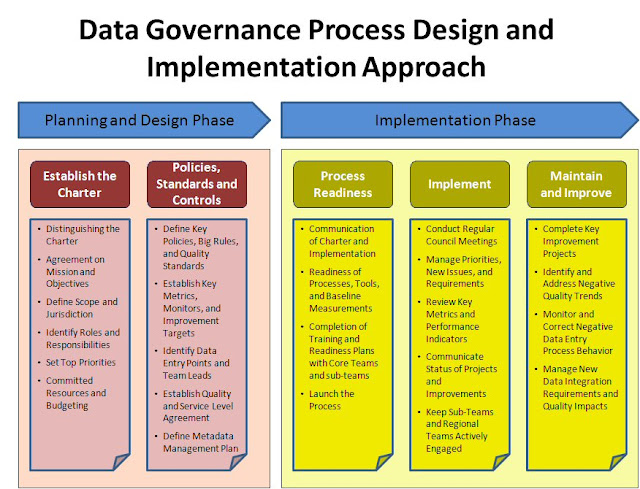Summary of Data Governance
Plan:
- Strategy & Approach
- Charter & Process
- People Involvement
- Quality Management
- Control Targets
Implementation
- Implementation Plan
- Priorities
- Measurement
- Training & Readiness
- Communication
Govern
- Manage
- Maintain
- Improve
- Communicate
- Mature
Starting a Data Governance Model
- Initial assessment and groundwork to drive a sound charter and implementation proposal
- Business driven initiative sponsored at VP level
- Led the program and initiative by Senior Director/Manager
- Data Governance Council (DGC) to have sufficient influence to ensure that data standards, validation rules, and quality control expectations are actively involved in business process areas.
Ten mistakes to avoid
- Failing to define data governance
- Ready, shoot, aim: Failing to design data governance
- Prematurely launching a council
- Treating data governance as a project
- Ignoring existing steering committees
- Overlooking cultural considerations
- Prematurely pitching data governance
- Expecting too much from a sponsor
- Relying on the big bang
- Being ill-equipped to execute
- Planning and Design Phase
1. Establishing the Charter
- Distinguishing the Charter
- Agreement on Mission and Objectives
- Define Scope and Jurisdiction
- Identify Roles and Responsibilities
- Set Top Priorities
- Committed Resources and Budgeting
2. Policies, Standard, and Control
- Define Key Policies, Big Rules, and Quality Standards
- Establish Key Metrics, Monitors, and Improvement Targets
- Identify Data Entry Points and Team Leads
- Establish Quality and Service Level Agreement
- Define Metadata Management Plan
- Implementation Phase
3. Process Readiness
- Communication of Charter and Implementation
- Readiness of Processes, Tools, and Baseline Measurements
- Completion of Training and Readiness Plans with Core Teams and sub-teams
- Launch the Process
4. Implement
- Conduct Regular Council Meetings
- Manage Priorities, New Issues, and Requirements
- Review Key Metrics and Performance Indicators
- Communicate Status of Projects and Improvements
- Keep Sub-Teams and Regional Teams Actively Engaged
5. Maintain and Improve
- Complete Key Improvement Projects
- Identify and Address Negative Quality Trends
- Monitor and Correct Negative Data Entry Process Behavior
- Manage New Data Integration Requirements and Quality Impacts

Great article, thank you for sharing the valuable information.
ReplyDeleteLeading Data Governance Services.